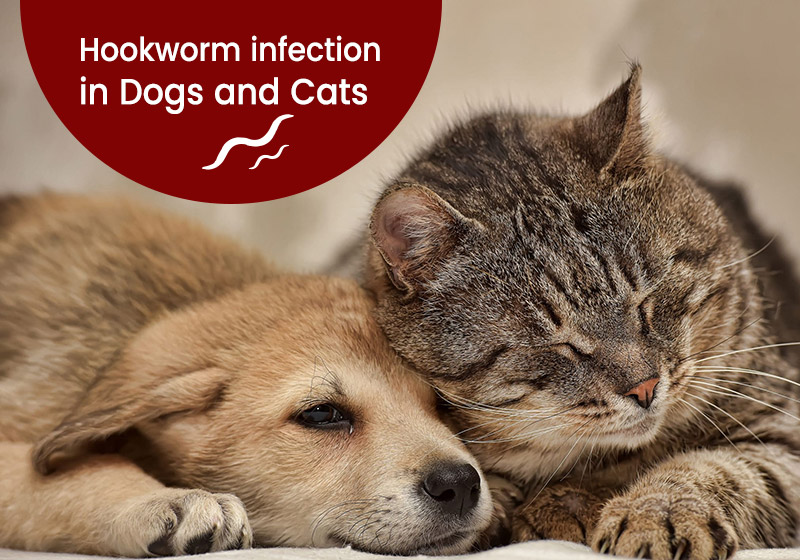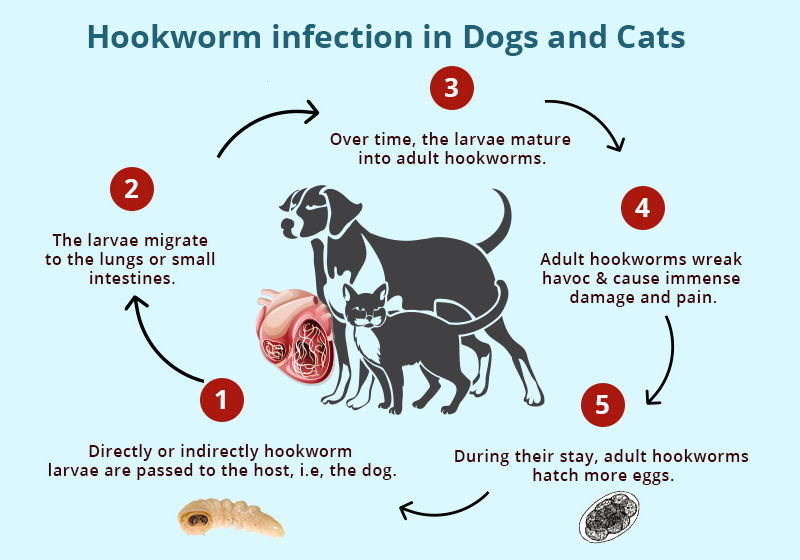Hookworm is a parasitic worm that infests the intestines of humans, dogs, and cats. It belongs to genera Necator and Ancylostoma of Nematoda class.

Lifecycle of Hookworms
Adult male and female hookworms mate in a dog’s intestine. Every day, the female worm lays several eggs. These eggs are released into the environment via feces. Within 24 to 48 hours, they develop into first-stage larvae (L1) and hatch. During the next 5 to 10 days, L1 molts into infective third-stage larvae and, L3 then infects a host by ingestion or penetrating into the skin.
Ingestion: L3 hookworms pass through the stomach into the small intestine. Here they infect the glands that line the intestinal wall. They emerge and mature into adults after a few days.
Skin penetration: L3 hookworms enter the body through the skin. They then travel through the bloodstream to the lungs, where they enter the trachea and are swallowed. They end up in the intestine.
Transmammary: Arrested larvae can reactivate during parturition and, can be passed on to puppies via the breastfeeding process. It is one of the most common ways how puppies are infected.

Hookworms in Dogs
Hookworms are nasty little worms that can do a lot of harm to your dog, so it’s vital for owners to be aware of them. Here’s what you need to know:
- The transmission of hookworms in dogs occurs: orally, through the skin, before birth (in utero) through the mother’s placenta, and through the mother’s milk.
- Female hookworms contaminate the atmosphere bypassing hundreds of microscopic eggs in the feces.
- Larvae hatch from the eggs and remain infective in the soil for weeks. The larvae are swallowed by the dog, where they mature and complete their life cycle in the intestinal tract.
- Common symptoms in dogs and puppies include: Anemia, appetite loss, diarrhea, excessive coughing, skin irritation, mostly between the toes and in and around the feet areas, and tarry and/or bloody poop
- Popular products to prevent hookworms in dogs include: Revolution, Advocate, Interceptor, Drontal
Hookworms in Cats
Ancylostomatubaeforme and Ancylostomabraziliense are the two types of hookworms found in cats. With a few variations, it is almost identical for cats and dogs:
- Kittens can’t get infected before they’re born or from nursing. They are usually infected by larvae that invade the skin or by consuming an infected prey animal. Infection from the ground can also happen but it is rare.
- Cats get contaminated by consuming a vertebrate host such as a mouse and cockroach. A scuttling bug is an appealing toy for cats. Moreover, a cockroach is a potential spreader of hookworm larvae it carries.
- Ivermectin, milbemycin oxime, emodepside (the active ingredient in Profender®), selamectin, and moxidectin are among the treatments approved for feline hookworm infection.
- Symptoms of hookworms in cats include: Small lesions, pale mucous membranes, poor coat, diarrhea, weight loss, constipation, loss of appetite, cough, breathing difficulties, and wheezing
- Popular products to prevent hookworms in cats include: Profender, Drontal, Paragard Wormer, Mediworm
Keeping parasites at bay is a vital aspect of being a good pet owner. Hope this blog will help you understand the signs and symptoms of hookworms in pets, as well as how to avoid them. We have made efforts to explain every small detail that will be beneficial to keep your pet happy, stable, and free of hookworms.
The final point is hookworms are preventable. Talk to your veterinarian about establishing a deworming schedule or buy worming tablets from Best Vet Care.
